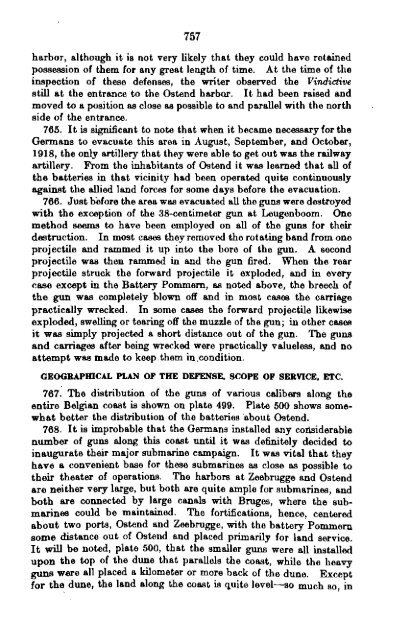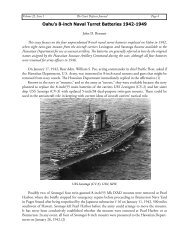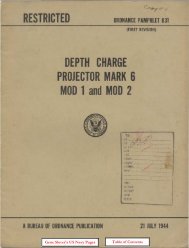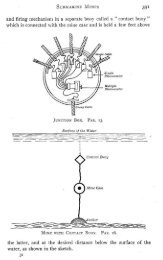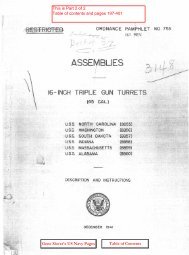...Railway artillery - Personal Page of GENE SLOVER
...Railway artillery - Personal Page of GENE SLOVER
...Railway artillery - Personal Page of GENE SLOVER
Create successful ePaper yourself
Turn your PDF publications into a flip-book with our unique Google optimized e-Paper software.
757<br />
harbor, although it is not very likely that they could have retained<br />
possession <strong>of</strong> them for any great length <strong>of</strong> time. At the time <strong>of</strong> the<br />
inspection <strong>of</strong> these defenses, the writer observed the Vindictive<br />
still at the entrance to the Ostend harbor. It had been raised and<br />
moved to a position as close as possible to and parallel with the north<br />
side <strong>of</strong> the entrance.<br />
765. It is significant to note that when it became necessary for the<br />
Germans to evacuate this area in August, September, and October,<br />
1918, the only <strong>artillery</strong> that they were able to get out was the railway<br />
<strong>artillery</strong>. From the inhabitants <strong>of</strong> Ostend it was learned that all <strong>of</strong><br />
the batteries in that vicinity had been operated quite continuously<br />
against the allied land forces for some days before the evacuation.<br />
, 766. Just before the area was evacuated all the guns were destroyed<br />
with the exception <strong>of</strong> the 38-centimeter gun at Leugenboom. One<br />
method seems to have been employed on all <strong>of</strong> the guns for their<br />
destruction. In most cases they removed the rotating band from one<br />
projectile and rammed it up into the bore <strong>of</strong> the gun. A second<br />
projectile was then rammed in and the gun fired. When the rear<br />
projectile struck the forward projectile it exploded, and in every<br />
ease except in the Battery Pommem, as noted above, the breech <strong>of</strong><br />
the gun was completely blown <strong>of</strong>f and in most cases the carriage<br />
practically wrecked. In some cases the forward projectile likewise<br />
exploded, swelling or tearing <strong>of</strong>f the muzzle <strong>of</strong> the gun; in other cases<br />
it was simply projected a short distance out <strong>of</strong> the gun. The guns<br />
and carriages after being wrecked were practically valueless, and no<br />
attempt was made to keep.them in.condition.<br />
GEOGRAPMCAL PLAN OF THE DEFENSE, SCOPE OF SERVICE, ETC.<br />
767. The distribution <strong>of</strong> the guns <strong>of</strong> various calibers along the<br />
entire Belgian coast is shown on plate 499. Plate 500 shows somewhat<br />
better the distribution <strong>of</strong> the batteries 'about Ostend.<br />
768. It is improbable that the Germans installed any considerable<br />
number <strong>of</strong> guns along this coast until it was definitely decided to<br />
inaugurate their major submarine campaign. It was vital that they<br />
have a convenient base for these submarines as close as possible to<br />
their theater <strong>of</strong> operations. The harbors at Zeebrugge and Ostend<br />
are neither very large, but both are quite ample for submarines, and<br />
both are connected by large canals with Bruges, where the submarines<br />
could be maintained. The fortifications, hence, centered<br />
about two ports, Ostend and Zeebrugge, with the battery Pommem<br />
some distance out <strong>of</strong> Ostend and placed primarily for land service.<br />
It will be noted, plate 500, that the smaller guns were all installed<br />
upon the top <strong>of</strong> the dune that parallels the coast, while the heavy<br />
guns were all placed a kilometer or more back <strong>of</strong> the dune. Except<br />
for the dune, the land along the coast is quite level-so much so , in<br />
Digitized by Coogle


